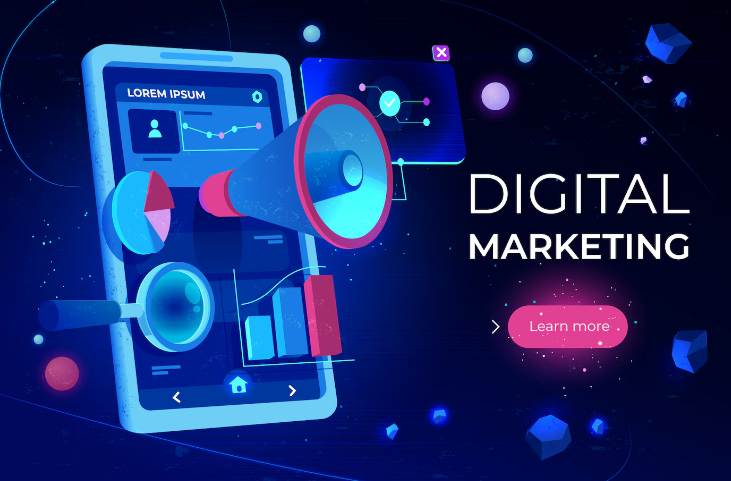Mastering Digital Marketing: Strategies for Online Success
In the current digital era, digital marketing has become an essential tool for businesses of all sizes. From startups to multinational corporations, every organization can benefit from a well-crafted digital marketing strategy. In this comprehensive guide, we will explore the various aspects of digital marketing, providing you with the knowledge and tools you need to succeed in the digital landscape.
What is Digital Marketing?

Digital marketing involves utilizing online channels and technologies to advertise products and services to both consumers and businesses. Unlike traditional marketing methods, digital marketing allows for targeted, data-driven, and highly interactive campaigns. The main channels utilized in digital marketing include:
- Search Engine Optimization (SEO)
- Content Marketing
- Social Media Marketing
- Pay-Per-Click (PPC) Advertising
- Email Marketing
- Affiliate Marketing
- Influencer Marketing
- Online PR
Each of these channels offers unique opportunities and challenges, and a successful digital marketing strategy will often incorporate a mix of these elements.
The Importance of Digital Marketing
In the modern business environment, digital marketing is crucial for several reasons:
Global Reach: Unlike traditional marketing, which is often confined by geographical boundaries, digital marketing enables you to access a worldwide audience, expanding your market potential and growth opportunities
Cost Efficiency: Digital marketing typically offers greater cost efficiency compared to traditional marketing methods. For example, email marketing and social media campaigns can reach thousands of people at a fraction of the cost of a TV ad or print campaign.
Measurable Outcomes: A key advantage of digital marketing is its capability to track and measure results. Tools like Google Analytics and social media analytics allow you to see how your campaigns are performing in real-time.
Targeted Campaigns: Digital marketing allows you to target specific demographics, interests, and behaviors. This means you can tailor your messages to the right people at the right time, increasing the chances of conversion.
Interactive and Engaging: Digital marketing channels, such as social media and email, allow for two-way communication. This means you can engage with your audience, answer questions, and build relationships in ways that traditional marketing methods cannot.
Key Components of Digital Marketing
1. Search Engine Optimization (SEO)

SEO involves optimizing your website to achieve higher rankings in search engine results pages (SERPs). The higher your site ranks, the more visible it becomes to potential customers. SEO involves several strategies, including:
Keyword Research: Identifying the specific keywords and phrases your target audience searches for.
On-Page SEO: Enhancing individual pages on your website to increase rankings and attract more relevant traffic. This includes elements like title tags, meta descriptions, header tags, and content optimization.
Off-Page SEO: Acquiring backlinks from reputable websites to enhance your site’s authority and credibility.
Technical SEO: Enhancing the technical aspects of your website, including site speed, mobile-friendliness, and crawlability..
2. Content Marketing

Content marketing entails crafting and distributing valuable, relevant, and consistent content to captivate and engage a well-defined audience, with the aim of prompting profitable customer actions. Various forms of content marketing include:
Blog Posts: Regularly updated articles on your website that provide value to your audience.
Ebooks and Whitepapers: In-depth guides that provide detailed information on a specific topic.
Infographics: Visual representations of information or data.
Videos: Engaging visual content that can be shared on social media, YouTube, and your website.
Podcasts: Audio content that can be consumed on the go.
3. Social Media Marketing

Social media marketing entails leveraging social media platforms to promote your products or services. The primary social media platforms include Facebook, Twitter, Instagram, LinkedIn, Pinterest, and Snapchat. Effective social media marketing strategies include:
Content Creation and Curation: Creating and sharing content that is relevant and engaging to your audience.
Community Management: Building and nurturing relationships with your audience by responding to comments, messages, and mentions.
Paid Social Advertising: Running targeted ads on social media platforms to reach a wider audience.
4. Pay-Per-Click (PPC) Advertising

PPC advertising requires payment for each click on your ad. This model allows you to bid for ad placement in search engine sponsored links when someone searches for a keyword related to your business. The most common PPC platform is Google Ads, but other platforms include Bing Ads and social media advertising (e.g., Facebook Ads, Instagram Ads). Key aspects of PPC include:
Keyword Research: Identifying optimal keywords to bid on.
Ad Creation: Crafting persuasive ad content that encourages engagement.
Bid Management: Setting and adjusting your bids to get the best return on investment (ROI).
Performance Tracking: Monitoring your campaigns and making adjustments based on performance data.
5. Email Marketing

Email marketing involves distributing commercial messages to a targeted audience via email. It is one of the most cost-effective digital marketing strategies and can deliver a high ROI when done correctly. Key components of email marketing include:
Email List Building: Collecting email addresses from your website visitors, social media followers, and customers.
Email Content Creation: Writing engaging and relevant email content that provides value to your audience.
Email Segmentation: Dividing your email list into segments based on demographics, interests, and behaviors.
Email Automation: Setting up automated email sequences to nurture leads and drive conversions.
6. Affiliate Marketing
Affiliate marketing involves collaborating with other businesses or individuals to promote your products or services. Affiliates receive compensation for each sale or lead they generate through their promotional efforts. This can be a cost-effective way to reach new customers and increase sales.
7. Influencer Marketing
Influencer marketing involves collaborating with influencers—individuals with significant followings on social media or other online platforms—to promote your products or services. Influencers can expand your reach and enhance your brand’s credibility.
8. Online PR
Online PR involves managing your brand’s reputation and building relationships with online media outlets. This can include press releases, media coverage, and influencer outreach. The goal is to increase your brand’s visibility and credibility.
Developing a Digital Marketing Strategy
A successful digital marketing strategy involves several key steps:
Clearly define your campaign objectives. Whether you’re aiming to drive website traffic, generate leads, increase sales, enhance brand awareness, or achieve a combination of these, having specific goals will guide your strategy and help measure success.
Identify Your Target Audience: Understand who your ideal customers are, including their demographics, interests, and behaviors. This will enable you to design campaigns that effectively engage and convert your audience.
Conduct a Competitive Analysis: Analyze your competitors’ digital marketing strategies to identify their strengths and weaknesses. This can help you identify opportunities and differentiate your brand.
Choose the Right Channels: Based on your goals and target audience, determine which digital marketing channels will be most effective for your business.
Create a Content Plan: Develop a content plan that outlines what type of content you will create, how often you will publish it, and where you will share it. This can encompass blog posts, social media updates, videos, infographics, and more.
Implement Your Strategy: Execute your digital marketing plan, using the tools and tactics that are most relevant to your business.
Monitor and Adjust: Regularly track the performance of your campaigns using analytics tools. Regularly review and refine your strategy to enhance performance and achieve optimal results.
Measuring Digital Marketing Success
To measure the success of your digital marketing efforts, you need to track key performance indicators (KPIs). Common KPIs include:
Website Traffic: Monitor the influx of visitors to your site over time.
Conversion Rate: Evaluate the proportion of visitors taking desired actions such as purchases or sign-ups.
Bounce Rate: Quantify the percentage of visitors who exit your site after viewing just one page, reflecting initial engagement and content relevance.
Click-Through Rate (CTR): The percentage of people who click on your ad or link.
Cost Per Click (CPC): The cost incurred each time a user clicks on your ad, typically determined through bidding on keywords or placement.
Return on Investment (ROI): The revenue generated from your digital marketing efforts compared to the cost.
By regularly monitoring these KPIs, you can identify what’s working and what’s not, and make data-driven decisions to improve your results.
Conclusion
Digital marketing is a powerful tool that can help you reach a global audience, engage with your customers, and drive profitable action. By understanding the key components of digital marketing and developing a strategic approach, you can position your business for success in the digital age. Remember to set clear goals, identify your target audience, choose the right channels, create valuable content, and regularly monitor your performance to ensure your digital marketing efforts are effective. With the right strategy in place, you can leverage the power of digital marketing to grow your business and achieve your goals.
Frequently Asked Questions (FAQ)
1. What is digital marketing?
Digital marketing encompasses leveraging online platforms like websites, social media, search engines, email, and mobile apps to effectively promote products or services to specific audiences. It encompasses various strategies, including SEO, PPC advertising, social media marketing, content marketing, and more.
2. Why is digital marketing important for businesses?
Digital marketing allows businesses to reach a wider audience, target specific demographics, and measure the effectiveness of their campaigns in real-time. It offers cost-effective ways to generate leads, increase brand visibility, and drive sales compared to traditional marketing methods.
3. What elements are essential in a digital marketing strategy?
A comprehensive digital marketing strategy typically includes:
Search Engine Optimization (SEO): Enhancing your website’s content and structure to improve its visibility and ranking in search engine results pages (SERPs).
Pay-Per-Click (PPC) Advertising: Paid ads on search engines and other platforms to drive traffic.
Social Media Marketing: Building meaningful connections with your audience across platforms such as Facebook, Instagram, Twitter, and more.
Content Marketing: Strategically crafting and circulating valuable content to captivate and retain your audience’s interest.
Email Marketing: Tailoring personalized email campaigns to foster leads and uphold enduring customer relationships.
Analytics and Data Analysis: Monitoring and measuring campaign performance to optimize strategies.
4. How can digital marketing help in increasing website traffic?
Digital marketing strategies such as SEO, PPC advertising, content marketing, and social media marketing can all contribute to driving more traffic to your website. By optimizing your website for search engines, running targeted advertising campaigns, creating valuable content, and engaging with your audience on social media, you can attract more visitors to your site.
5. What metrics indicate the impact of a digital marketing campaign?
The success of a digital marketing campaign can be measured using various key performance indicators (KPIs), including:
Traffic Metrics: Website traffic, page views, and unique visitors.
Conversion Rates: Percentage of visitors who complete desired actions, such as making a purchase or filling out a form.
ROI (Return on Investment): Revenue generated compared to the cost of the campaign.
Engagement Metrics: Social media likes, shares, comments, and email open rates.
Customer Acquisition Cost (CAC): Cost to acquire each new customer through digital marketing efforts.
6. How can businesses use social media for digital marketing?
Social media platforms like Facebook, Instagram, LinkedIn offer businesses opportunities to connect with their target audience, build brand awareness, and drive engagement. Strategies include creating engaging content, running targeted ads, interacting with followers, and using analytics to refine your approach.
7. What are some common digital marketing mistakes to avoid?
Common digital marketing mistakes include:
Not having a clear strategy: Failing to define goals, target audience, and key metrics.
Ignoring mobile users: Neglecting to optimize websites and content for mobile devices.
Overlooking SEO: Not investing in search engine optimization to improve visibility.
Ignoring analytics: Not tracking and analyzing campaign performance to make data-driven decisions.
Not engaging with the audience: Failing to respond to comments, messages, and feedback on social media.
8. How can small businesses get started with digital marketing?
Small businesses can start with digital marketing by:
Setting clear goals: Define objectives such as increasing website traffic, generating leads, or boosting sales.
Creating a website: Develop a user-friendly website that reflects your brand and offers valuable content.
Utilizing social media: Establish a presence on platforms where your target audience is active.
Learning and adapting: Stay informed about digital marketing trends and techniques, and be willing to adjust strategies based on results.
9. What role does content marketing play in digital marketing?
Content marketing focuses on crafting and sharing valuable, relevant, and consistent content to engage and retain a specific audience. It aids businesses in fostering trust, establishing industry authority, and fostering engagement. Content may encompass blog posts, videos, infographics, podcasts, and diverse mediums.
10. How can digital marketing help in increasing brand visibility?
Digital marketing strategies such as SEO, social media marketing, and content marketing can all contribute to increasing brand visibility. By optimizing your website for search engines, sharing valuable content on social media, and engaging with your audience online, you can enhance brand awareness and reach a wider audience.


Very nice blog 👍